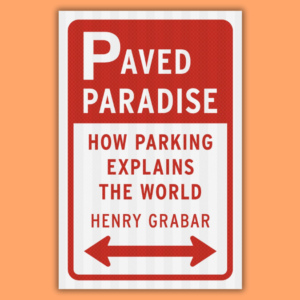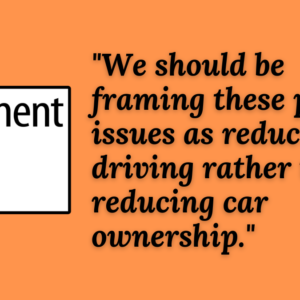You can learn so much in the Comments sections. In last week’s story about the concrete drums PBOT installed on NE 21st, Jonathan issued a correction. A commenter had pointed out that PBOT has jurisdiction of the 21st Avenue overpass over I-84, not ODOT, as he had written.
Jonathan then took to the comments to bemoan how “confounding” are the jurisdictional boundaries of Portland’s streets. And don’t you know that started a long, informative, sub-thread? A couple of commenters offered links to the maps they use to determine road ownership, testiness ensued, finally Quint stepped in. What I liked about Quint’s comment is that they explained why things are the way they are. I always appreciate that.
Here’s Quint’s explanation of jurisdictional control of overpasses in Portland:
Correct, most of the bridges across I-5 and I-205 are owned by ODOT, even the ones with PBOT roadways going over them. I think it has to do with the fact that I-84 was built inside a natural gulch. Because it was a gulch, most of the bridges already existed and were owned by PBOT, and I-84 was just built underneath the bridges. Even when a bunch of them were partially rebuilt in the 80s for the MAX project, there must have been some agreement that they remain under PBOT ownership.
From what I can remember looking at the bridge maps that used to be on PBOT’s old website (they seem to be missing from the new one), the only I-84 bridges that belong to ODOT are the ones that carry roads that used to be ODOT highways. So basically there seems to be a practice where even if a highway is transferred from ODOT to PBOT, ODOT keeps ownership of the bridges. So the Grand/MLK bridges are still ODOT, even though Grand/MLK (aka US Hwy 99E) was transferred to PBOT sometime in the 90s (I think). The Sandy Blvd bridge is still ODOT, even though Sandy Blvd (formerly designated as US Hwy 30) was transferred to PBOT in the 00s. And the 82nd Ave bridge is still ODOT even though 82nd Ave (aka OR Hwy 213) was transferred to PBOT last year. The Halsey bridge over 82nd Ave is also ODOT-owned, even though it’s a PBOT roadway, probably because it was built as part of a complex interchange and was not a previously-existing bridge.
I-5 and I-205 were built later, and created new trenches that needed new bridges to cross them, so in those cases ODOT built them as part of the project and kept ownership over them long-term.
Thank you Quint! We all know a bit more now. You can also read Quint and all the other comments in context.








Thanks for reading.
BikePortland has served this community with independent community journalism since 2005. We rely on subscriptions from readers like you to survive. Your financial support is vital in keeping this valuable resource alive and well.
Please subscribe today to strengthen and expand our work.
There are multi-page agreements between ODOT and the different jurisdictions that determine the final ownership and maintenance of each and every structure. Bridges, traffic signals, stripping for crosswalks, etc. They are known as “Blue-backs” because the agreements are bound with a blue cardboard backing.
The ODOT Bridge Log is a good resource, and also confirms Quint’s comment. Basically all the bridges over I-84 west of 82nd are maintained by the city (outside the former state highways), while the few that are east of 82nd (I think just 102nd and Halsey) are maintained by ODOT – even though they were never state highways.
This makes me curious whether 102nd Avenue even connected over the railroad prior to I-84 and I-205 construction. The fact that the bridge belongs to ODOT suggests that maybe there was no previous bridge there…or maybe there was a bridge but it was completely rebuilt, rather than the I-84 ones that already existed before there was a freeway. It also would have been under Multnomah County jurisdiction at the time the freeways were built, given 102nd Ave is well past the city limits pre-1980s annexation. I would love to know the answer to this if there are any East Portland road network historians out there.
Interesting ODOT document, Blumdrew, thanks for the link. The Halsey overpass is ODOT but PBOT maintains the deck. Part of the 102nd Ave overpass was built in 1935, but most of it is from the 50s, and it seems to be owned by ODOT, but my guess is either Multmomah County or UPRR built it originally – PBOT has some deck maintenance responsibilities on 102nd as well. The little narrow bridge east of 102nd was built in 1979 and is owned by UPRR – in the EPIM it was listed as a future bikeway, but apparently the city staff didn’t realize it wasn’t owned by either the city nor ODOT. There are some other UPRR bridges as well, but the rest is mostly ODOT.
All major roads also have many viaducts and half-bridges over long buried creeks, streams, and slopes, including PBOT stroads.
I’m guessing 102nd was an existing bridge over the railroad, and then ODOT majorly cut into the hillside to the south when they built I-84, warranting a big extension of the existing bridge. Look at the massive retaining wall on the south side at 102nd.
In 1940, the road existed at least. I can’t really tell from that map if there was a bridge or not (and annoyingly, USGS does not have any maps of the area between 1910 and 1940). David says below that part of the overpass was built in 1935 – I imagine that the roadway predates the bridge though. 102nd is close enough in, and the area around Maywood Park and Parkrose developed rather early by east Portland standards (102nd did extend north as early as 1905 – though not all the way to railroad).
All the “two” roads follow Township & Range section lines of one mile square, very much like most of the Midwest, West, and even parts of the Deep South. 21st/22nd, 42nd, 62nd, 82nd, 102nd, 122nd, 142nd/143rd, 162nd, and 181st/182nd are all north-south section line roads. East-west section line roads include Division (by definition), Stark, Halsey, Fremont, Killingsworth, Holgate, Duke, & Clatsop. There are also quarter-section (such as Hawthorne) and quarter-of-a-quarter line roads. Most date from the mid-1800s.
The railroads are another story. Most Oregon rail lines were built between 1870 and 1900, but they acquired their rights-of-way (and huge chunks of free land) much earlier, sometime between when Oregon was ceded to the US in 1846 and statehood in 1859.
I figured there was probably something about the “2” roads – thanks for that clarity.
Concerning railroads, most of the railroads didn’t really acquire their rights of way and corresponding land grants until some portion of the line was actually built. This was usually a nominal distance, but had ramifications for the Portland area in the Eastside vs. Westside company thing. And the railroads (both named Oregon Central at first) were chartered around 1866 (Oregon was left out of the Pacific Railway Act of 1862), and laid their first tracks in 1869. The Eastside company won out, and was subsumed by the Southern Pacific octopus in 1887 – shortly after reaching California. No railroads acquired rights of way and land grants in Oregon before statehood as far as I know.
Aw, thanks for the comment of the week shout-out! Glad to hear my amateur transportation history nerdiness is appreciated by others.
I assume this ownership/responsibility includes the sidewalks? Just asking so I can continue to shake my fist at PBOT when they put out the “property owners are responsible for clearing the adjacent sidewalks” in the next snow/ice storm as I slip and slide on either the SE Holgate bridge over UPRR or the SE 17th flyover Powell at Gideon. (PBOT has never cleared either of those in the 10 years I’ve been using them, FWIW).
I would assume PBOT has jurisdiction over sidewalks on all the bridges. Even in the former state highway cases (like Grand/MLK) PBOT has jurisdiction over the roadway/sidewalks, while ODOT maintains responsibility over the physical structure of the bridge.
PBOT absolutely has full jurisdiction over the Holgate bridge, while ODOT has jurisdiction over the SE 17th flyover – except the bit that carriers UPRR where they maintain the deck that has the railway on it. I thought TriMet might have been involved since it carries the MAX but no note of that in the Bridge Log (page 304).